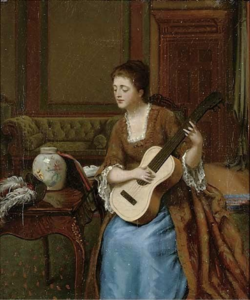by Johnny Hurst
 Following CPB-London’s recent ‘imagine a’ campaign:[1] picture a guitarist. Are they a man? They shouldn’t be. Not only should you not assume a man – historically, you should assume a woman. So why has this changed? And how does this relate to the accusations of Wet-Leg being ‘industry plants’? Let’s start at the beginning…
Following CPB-London’s recent ‘imagine a’ campaign:[1] picture a guitarist. Are they a man? They shouldn’t be. Not only should you not assume a man – historically, you should assume a woman. So why has this changed? And how does this relate to the accusations of Wet-Leg being ‘industry plants’? Let’s start at the beginning…
The Guitar and femininity
 The association between masculinity and guitars is a relatively recent phenomenon. Originally, the guitar was a paradigmatic feminine instrument. In 1783, Carl Junker named the guitar’s predecessors[1] as one of the 4 women-appropriate instruments (Stenstadvold, 2013). In the early 1700s, Roger North echoes this judgement (ibid). These pro-women guitar stances weren’t a stand against sexism: the guitar’s slender frame allowed women to remain elegant whilst playing. The guitar was also not a professional instrument[2] – it was an amateur instrument, played at home (Stenstadvold, 2013), accompanying[3] another instrument (Jackson, 2020). Thus, the project for modern women guitarists is not to create a feminine space in the guitar-world, but to reclaim it.
The association between masculinity and guitars is a relatively recent phenomenon. Originally, the guitar was a paradigmatic feminine instrument. In 1783, Carl Junker named the guitar’s predecessors[1] as one of the 4 women-appropriate instruments (Stenstadvold, 2013). In the early 1700s, Roger North echoes this judgement (ibid). These pro-women guitar stances weren’t a stand against sexism: the guitar’s slender frame allowed women to remain elegant whilst playing. The guitar was also not a professional instrument[2] – it was an amateur instrument, played at home (Stenstadvold, 2013), accompanying[3] another instrument (Jackson, 2020). Thus, the project for modern women guitarists is not to create a feminine space in the guitar-world, but to reclaim it.
 So, when did guitar’s feminine-status decline? Pinpointing a date here is difficult. Whilst the well-known Delta-Blues players of the early 20th Century are all men,[4] we have to recognise that history might be filtering out women-guitarists of this time through looking backwards with a guitar-as-masculine lens. Elizabeth Cotten writes Freight Train 20 years before Robert Johnson steps into a studio. Cotten even used a left-handed-upside-down string technique,[5] later used by[6] male-guitarists Albert King and Jimi Hendrix. Sister Rosetta-Tharpe could be seen ripping on an SG Custom in the early 1960s. So when did the change occur?
So, when did guitar’s feminine-status decline? Pinpointing a date here is difficult. Whilst the well-known Delta-Blues players of the early 20th Century are all men,[4] we have to recognise that history might be filtering out women-guitarists of this time through looking backwards with a guitar-as-masculine lens. Elizabeth Cotten writes Freight Train 20 years before Robert Johnson steps into a studio. Cotten even used a left-handed-upside-down string technique,[5] later used by[6] male-guitarists Albert King and Jimi Hendrix. Sister Rosetta-Tharpe could be seen ripping on an SG Custom in the early 1960s. So when did the change occur?
 Strohm points to the invention of the electric guitar (Weinstein, 2013). This makes sense: before amplification, the guitarist had the quiet role at the back of the Big-Band. Once amplified, the guitar could take the lead role (ibid).
Strohm points to the invention of the electric guitar (Weinstein, 2013). This makes sense: before amplification, the guitarist had the quiet role at the back of the Big-Band. Once amplified, the guitar could take the lead role (ibid).
 Enter the men. Amplification permits distortion: the aggressive sound of rock. Here we start to see the masculine paradigms work their way in. Then comes the virtuoso; the fiery and phallic displays in the late 1960s.[7] This trajectory continued: think 1970’s and 1980’s “masturbatory” (Weinstein, 2013, p. 144) guitar solos[8] – the guitar was cemented as a masculine domain.
Enter the men. Amplification permits distortion: the aggressive sound of rock. Here we start to see the masculine paradigms work their way in. Then comes the virtuoso; the fiery and phallic displays in the late 1960s.[7] This trajectory continued: think 1970’s and 1980’s “masturbatory” (Weinstein, 2013, p. 144) guitar solos[8] – the guitar was cemented as a masculine domain.
So how did this affect guitars?
 Firstly, once the guitar had been made masculine, the unspoken rule of ‘standard’ coming to mean ‘masculine’ instantiated itself.[9] The masculine way of playing guitar became the standard way of playing guitar. Deviation from this standard was/is seen as a mark of the amateur. Look at how Jett, St. Vincent and Millington[10] stand in powerful, assertive, masculine poses when performing.[11]
Firstly, once the guitar had been made masculine, the unspoken rule of ‘standard’ coming to mean ‘masculine’ instantiated itself.[9] The masculine way of playing guitar became the standard way of playing guitar. Deviation from this standard was/is seen as a mark of the amateur. Look at how Jett, St. Vincent and Millington[10] stand in powerful, assertive, masculine poses when performing.[11]
Masculine-as-standard worked in another way: guitars were now made for male-bodies. A standard-size guitar today is not a standard-sized guitar for a human body; it’s the standard-size for a male body. Perez (2019) talks about this problem for pianos: the keyboard was designed with only male hands in mind.[12] This can be seen in the size difference between guitar brands like Teisco in the 1950s[13] and the larger Gibson and Fender guitars that continued from the 50s onwards. Teisco guitars are shorter, so are retrospectively dubbed as student/3/4 sized[14] guitars. Perhaps they’re not smaller versions of ‘standard-sized’ guitars, they are just guitars not made for men! Moreover, guitars such as Teiscos had a revival in women-driven punk-bands. Perhaps they wanted to use a guitar that fits![15]
Thus women in the modern-age are faced with a dilemma: they must play guitar like a man[16] on an instrument that is too big for them to do so. Here enters Wet-Leg.
Wet-Leg and unapologetic rejection of normative-masculinity
Wet-Leg are a new alternative band. Neither Wet-Leg guitarist plays with the violence, aggression or domination of the instrument that the male-standardised perspective insists on.[17] Wet-Leg doesn’t need to perform masculinity to perform the role of guitarist; they perform the role of ‘guitarist’ continuously with their performance of femininity.
 Against the masculine-as-standard backdrop, Wet-Leg’s deviation from masculine-styles of guitar-playing is viewed as a deviation from ‘good’ guitar-playing. One video that centres Wet-Leg’s guitar-style is riddled with comments expressing their disgust for it. So Wet-Leg refuse to play guitar like men. And thus fuels the fire of ‘industry plant’ accusations.
Against the masculine-as-standard backdrop, Wet-Leg’s deviation from masculine-styles of guitar-playing is viewed as a deviation from ‘good’ guitar-playing. One video that centres Wet-Leg’s guitar-style is riddled with comments expressing their disgust for it. So Wet-Leg refuse to play guitar like men. And thus fuels the fire of ‘industry plant’ accusations.
Inference to Industry Plants
Innumerous Tiktok comments accuse Wet-Leg of being ‘Industry Plants’.[18] Whilst there’s no single reason why, I think their rejection of masculinity-as-standard is a strong factor.
Viewers see Wet-Leg’s non-masculine style of playing, and because non-masculine is seen as bad, Wet-Leg’s guitar-playing is seen as bad/amateur. If Wet-Leg are amateur musicians, then how have they had viral hits? The answer is simple! Wet-Leg’s success is the industries work, not theirs! Thus the apparent inability of Wet-Leg’s guitarists is squared with their commercial success.
Only, the viewer is wrong; they’ve mistaken non-masculine guitar-playing for bad guitar-playing. Wet-Leg aren’t amateur guitarists, they are women guitarists who have succeeded on their own merit! It turns out, Wet-Leg are actually just a decent band!

[1] The Lute and Zither
[2] The guitar not being part of the orchestra
[3] Read: being subservient to
[4] Think Robert Johnson, Son House, Lightning Hopkins…
[5] Seen being used by Cotten herself here: https://www.youtube.com/watch?v=IUK8emiWabU
[6] And often incorrectly credited to
[7] Think Jimi Hendrix’s wild onstage movements, and sitting his guitar on fire at the Monterey Pop Festival in 1967
[8] Think Van Halen, Guns ‘n Roses, Bon Jovi, Def Leppard…
[9] For a more detailed discussion of male-as-standard phenomena across historical data and modern society, see Perez’s “Invisible Women” (Perez, 2019)
[10] Of the 1970s all female rock group ‘Fanny’ who I recommend. Especially their cover of Marvin Gaye’s ‘Ain’t that Peculiar’
[11] I’m not saying here that these fantastic female guitar-players are ‘pretending to be men’, but instead pointing out that we seem to celebrate and hold in higher acclaim female guitarists who play guitar ‘like men’.
[12] See Perez (2019) Chapter 7: One-Size-Fits-Men
[13] Production ending early 1960s
[14] Presumably ¾ the size of a standard male body
[15] Where more standard brands of guitar were used, female alternative rock bands often use guitar models with shorter scale lengths, such as the Fender Mustang, or Gibson Les Paul Jr (notice the ‘Jr’: it’s the smaller, younger and inferior guitar to the flagship, men-in-mind Gibson Les Paul).
[16] With deliberate reference here to Young’s (1980) ‘Throwing Like a Girl’
[17] See an example of Wet Leg’s Teasdale playing guitar here: https://vm.tiktok.com/ZMLf7ybTN/?k=1
[18] An Industry Plant is a band/artist manufactured by a record label to be commercially successful, though presented as a grass-roots musician.
[1]https://l.facebook.com/l.php?u=https%3A%2F%2Fwww.instagram.com%2Fp%2FCa2WkCbsudA%2F%3Futm_medium%3Dcopy_link%26fbclid%3DIwAR3iZduqT2x-_4NxUQh8dpByUrmBDp4oEZSO8rMILcTnFF0izCVKOsEaqKc&h=AT1E5QZMoawxA48ZUgQKnVYYJ8BIHSzamX_oSsYbj-5sfjThHBbQKbPLBFvWs-LiavMUA3l_LK3BvvD2SGtZoysUaNVpsb7hKe9A65MOdqx1V0IFILn4mQKJTkYi7TENzmspfg
Further Reading:
Industry Plants – Another Form of Sexism in Music – Amika Moser
A nice short piece by Amika Moser on how accusations of industry plants are linked with sexism.
https://www.unpublishedzine.com/music-1/industry-plants-another-form-of-sexism-in-music
At First, the Guitar was a “Women’s Instrument” – Ashawnta Jackson
A short article from Ashawnta Jackson on the historical relationship between women and the guitar, which served as the inspiration for this blog post
“Women and the Electric Guitar” – Mavis Bayton (Chapter 3 of ‘Sexing the Groove”, edited by Sheila Whiteley
A moderately long piece on the Electric Guitar and women, touching on Gender Performance à la Judith Butler
Rock’s Guitar Gods — Avatars of the Sixties – Deena Weinstein
An academic article discussing the image of the Guitar God in the 1960s – see page 151 onwards for Weinstein’s discussion of masculinity!
https://www.jstor.org/stable/24467204
Wet Leg’s Spotify: https://open.spotify.com/artist/2TwOrUcYnAlIiKmVQkkoSZ?si=vI5Hbi0mR6imstryitFlhg
Chaise-Longue is currently their biggest hit
Works Cited
Jackson, A., 2020. At First, the Guitar Was a “Women’s Instrument”. [Online]
Available at: https://daily.jstor.org/at-first-the-guitar-was-a-womens-instrument/
[Accessed 12 03 2022].
Perez, C. C., 2019. Invisible Women: Exposing data bias in a world designed for men. London: Chatto & Windus.
Stenstadvold, E., 2013. ‘We hate the guitar’: prejudice and polemic in the music press in early 19th-century Europe. Early Music, 41(4), pp. 595-604.
Weinstein, D., 2013. Rock’s Guitar Gods — Avatars of the Sixties. Archiv für Musikwissenschaft, Volume 70, pp. 139-154.
Young, I. M., 1980. Throwing like a girl: A phenomenology of feminine body comportment motility and spatiality. Human Studies, 3(1), pp. 137 – 156.
